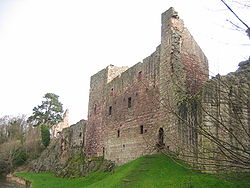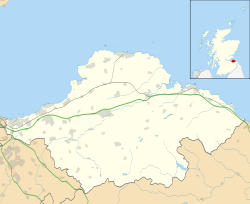Hailes Castle
| Hailes Castle | |
|---|---|
| Near East Linton, East Lothian, Scotland NT574757 |
|

North front of Hailes Castle, as seen from the River Tyne.
|
|
| Coordinates | 55°58′21″N 2°41′03″W / 55.97239°N 2.68412°W |
| Site information | |
| Owner | Historic Scotland (as Guardian) |
| Controlled by | Hepburn family |
| Condition | Ruin |
| Site history | |
| Built | 13th to 16th centuries |
| Built by | Hugo de Gourlay |
| Materials | Stone |
Hailes Castle is a mainly 14th century castle about a mile and a half south west of East Linton, East Lothian, Scotland. This castle, which has a fine riverside setting, belonged to the Hepburn family during the most important centuries of its existence. Since 1926, it has been the subject of a state-sponsored guardianship agreement, which is now under the auspices of Historic Scotland. It is open to the public without charge at all reasonable times.
The castle was founded as a fortified tower house by Hugo de Gourlay before 1300, making it one of the oldest constructions of its kind in Scotland. The superiority of the lands was held by the Earls of Dunbar and March. The de Gourlays, a Northumbrian family, supported the English in the Wars of Independence, and their land was forfeited by order of the Scottish Crown. Hailes Castle and lands were then confirmed upon another Northumbrian, Sir Adam de Hepburn (d. before 1371), who, in the reign of David II, had a charter of the lands of Traprain, and Southalls and Northalls (now united and called Hailes) in Haddingtonshire, as well as the lands of Mersingtoun, Cockburnspath, and Rollanstoun in Berwickshire.
On December 20, 1451, Sir Patrick Hepburn, 1st Lord Hailes, had a Crown charter of the Lordship of Hailes and other lordships and lands, which his predecessors formerly held in heritage of the Earls of March, who again held them of the Crown in chief; also the lands of Prendergast, above Ayton, and others in the sheriffdom of Berwick, with all rights in the lands formerly held by George Dunbar, Earl of March, and forfeited by him: the whole erected into a free barony to be called the Barony of Hailes. He was one of the conservators of truces with England in 1449, 1451-7 and 1459. It is thought that Sir Patrick Hepburn dramatically extended the castle. A massive tower of at least four storeys was built to the west of the original construction, and a lower tower to the East to form a long north range, looming above the river Tyne. The thick curtain wall of the castle may date back to the 13th century.
...
Wikipedia

